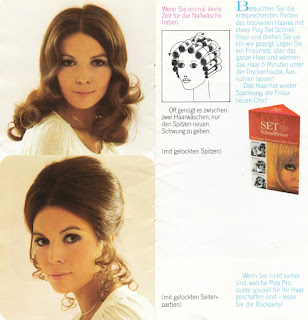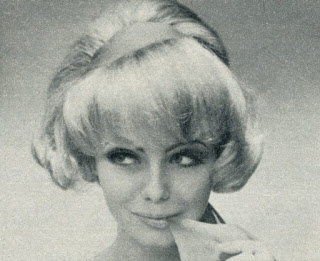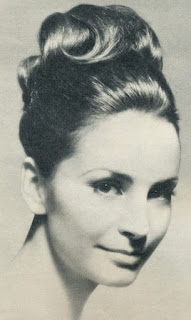Here is the whole booklet. Even if you don't speak German you can always read the pictures. It does have setting diagrams for each of the vintage hairdos:
Perhaps the best part of the booklet is the front cover showing a wetset with classic German wire brush rollers.
German brush rollers are similar to ours but as you might expect, much more solid.
Unfortunately the mesh on the rollers is so fine that you cant use plastic piks to hold them. Instead either solid metal piks that often come with the rollers or wire pins have to be used. I have never found either to be a great option.
The metal piks don't bend at all, and with the solid rollers the choice is either too loose with rollers falling out, or very tight which is fine for air drying during the day or under the dryer, but too uncomfortable for sleeping in.
Fine wire pins are more comfortable, but you can only use them from roller to roller which make set a bit less secure and harder to do.
I do occasionally like to use German rollers for a nice tight set, but due to the lack of more flexible piks that fit I don't use them as much as I would otherwise. I should look for finer plastic piks - I have seen some that a metal coated plastic that might work with these otherwise great rollers. (Have you ever used these rollers? How do you secure them? Let me know!).
The dryer itself is easy to use although the stand is bit flimsy. It sure beats the American style tabletop style dryers which are always hard to get positioned at the right height. With the fan in top of the dryer its much more like a real salon dryer than a home one, and takes only a bit more time for drying. All in all, a very nice home dryer and as you might expect from a European item.
Another dryer you often see from the same period is the Braun floating bonnet dryer. I did a blog on it here http://incurlers.blogspot.com/2011/11/braun-floating-bonnety-dryer.html. Without repeating too much, its surprisingly disappointing. Rather than actually floating comfortably on the inflated bonnet (like the Sunbeam dryer did) it actually sits on your top curlers and presses down on them. I'd take the Krups dryer over the Braun on any day.
It looks like this floating bonnet dryer from Krups would be much more comfortable (wish I had one to try).
I found one nice vintage magazine with some insights and how-tos of vintage European hairdressing: the German magazine Petra (February 1966). It features a few models and their hairdos. Here are few of them:
Ina
One model, Ina, is shown with a particularity nice soft hairdo as well as a few others:
The article talks about the rollers she uses:
With the help of Google translate (and if you can improve the translation please let me know!):
"1. Those who, like Ina , need a lot of tension on their hair, should use Drahtwickler, perhaps with a prickly insert. They make sure the hair lies smoothly on the roller. 2. Those who not very good at winding rollers should use Igelwickler that almost hold themselves. They are made out of plastic and and have little bristles also made out of plastic . 3. Those who have particularly long hair should use Filiganwickler."
Drahtwicker are German wire mesh rollers. I presume Igelwickler as plastic brush rollers, and I found a picture of Filiganwickler on Ebay:
And shows her set:
The article also has picture of her in a curler cap, saying she because she is so often is in curlers that she wears the curler cap to to look pretty:
"1. Its not a secret: rollers are not jewelry for the head. Those who spend so much time in rollers like Ina have to do something for their curler head. They must put them under a bonnet. There are many pretty bonnets from which every lady can find one that she likes. Covered with frills or made out of lace, with soft pastel tones or bright colors. 2. When Ina was just at the hairdresser, she also puts her hair under a bonnet overnight. That way the hairdo doesn't immediately fall out and can be done nicely the next morning."
Ina's hair do is a classic example of how brush rollers are ideal for beautiful soft styles that may or may not be curly. Her routine often being in tightly wound rollers is typical of 1960s home hairdressing and has a lot of merit: it leaves hair with a very nice texture and soft look. This section on her hair how-to is also titled (translated) "Ina: My (hairdressing) trick costs little money or time" which also dispels the myth that regular wetsets have to take a lot of time.
Although its not the same model, the magazine also showed the classic scarf-over-curlers look, which would have been a good alternative for Ina to wearing a curler cap:
Daniela
Daniela seems to wear slightly more elaborate hairdos:
Her set for all of them is below:
Lissy
Two simple hairdos and one fancy one:
And her set:
Maggy
Some really classic updos:
Her set:
Hope you enjoyed this blog posting, and if you have any insights into vintage European hairdressing, please post them as a comment!



































No comments:
Post a Comment